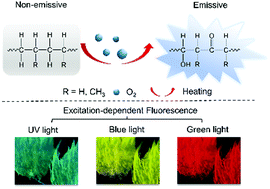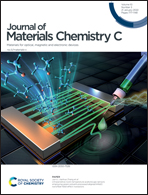Transforming polyethylene and polypropylene into nontraditional fluorescent polymers by thermal oxidation†
Abstract
Polyolefins like polyethylene (PE) and polypropylene (PP) without any conventional or nonconventional fluorescent chromophores have never been considered as raw materials for the preparation of fluorescent polymers. Here we report that PE and PP can be transformed into nontraditional luminescent polymers (NLPs) with strong fluorescence emissions by a simple thermal oxidation method. The maximum excitation and emission wavelengths of PE and PP oxidized products generally firstly increase with the increase of heating temperature and time, and then decrease. In addition, the oxidized products also exhibit significant excitation-dependent fluorescence (EDF) characteristics. Oxygen-containing nonconventional chromophores like hydroxyl, carbonyl and ester groups are proven to be formed in the PE and PP oxidized products. The formation of extended through-space n–π* and π–π* interactions among the nonconventional chromophores leads to the fluorescence emissions. Fluorescence emissions can also be introduced onto PE and PP surfaces by fast flame burning, and its application in anti-counterfeiting is demonstrated. This work is of great scientific importance in understanding the origin of fluorescence and will have an important impact on the development and practical applications of fluorescent materials.



 Please wait while we load your content...
Please wait while we load your content...